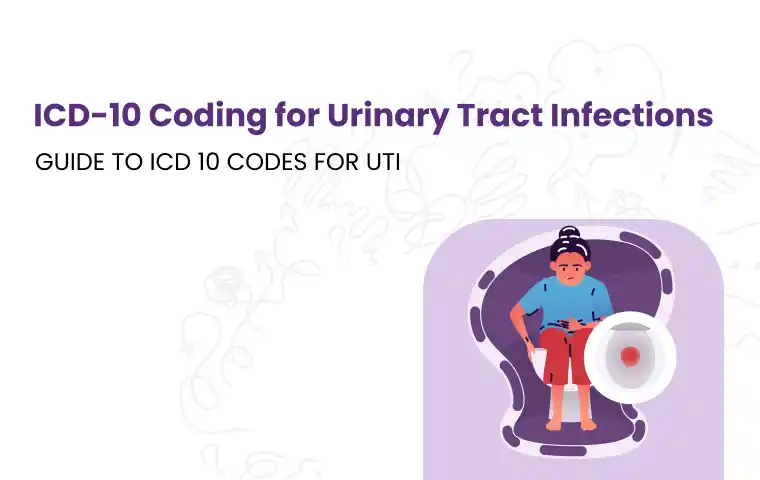When it comes to coding and billing for Urinary Tract Infections (UTIs), many healthcare providers might assume it’s as straightforward as coding for a simple infection. However, UTI coding within the ICD-10 system presents unique challenges, especially when compared to other infectious diseases that may have clear connections to systemic conditions, chronic illnesses, or complications like kidney involvement.
With UTIs, coders must cover a range of variables, from acute versus chronic infections to complications stemming from diabetes, catheter use, and more. This guide compiles the essential ICD-10 codes for a wide array of UTI scenarios, helping you streamline your coding processes and achieve accuracy and efficiency in every claim.
Whether you’re a seasoned urologist or part of a healthcare billing team, this comprehensive resource is designed to make UTI coding straightforward, accurate, and in alignment with best practices. Let’s dive into everything you need to know about coding for UTIs in ICD-10—and take the stress out of managing UTI claims!
Which ICD-10 Codes Should You Use for Urinary Tract Infections (UTIs)?
When coding for Urinary Tract Infections (UTIs) under the ICD-10 system, it’s essential to understand the distinctions between various types of infections, complications, and patient-specific factors.
ICD 10 Code for UTI When Site is Unspecified
In cases where a patient is diagnosed with a Urinary Tract Infection (UTI), but the specific site of infection within the urinary tract is not identified, ICD-10 code N39.0 should be used. This is the most general code for UTIs and applies when the infection could be located anywhere in the urinary system, but the precise location (e.g., bladder, kidney) is either unknown or unspecified in the documentation.
Key Points for Using N39.0:
-
Appropriate Use: N39.0 is ideal for general UTI cases where there’s no clear indication of the infection affecting specific areas like the kidneys or bladder.
-
Clinical Scenarios: Commonly used in primary care or urgent care settings where the diagnosis may be made based on initial symptoms or preliminary tests without detailed imaging or lab results.
-
Documentation Tip: While N39.0 is widely used, specificity is always preferred. If the healthcare provider can specify the infection site or nature (e.g., cystitis or pyelonephritis), a more specific code should be selected.
ICD 10 Codes for UTI with Nature Specified
UTIs can present with different characteristics, commonly classified into three main types: cystitis, pyelonephritis, and urethritis.

1. Cystitis (Bladder Infection)
Cystitis refers to a UTI localized in the bladder. There are separate codes depending on whether the infection involves hematuria (blood in the urine).
N30.0 – Acute Cystitis Without Hematuria
Use this code when the patient has an acute bladder infection without any presence of blood in the urine. It reflects a straightforward, non-complicated cystitis case.
N30.01 – Acute Cystitis With Hematuria
This code applies to cases of acute cystitis where hematuria is present. Hematuria may indicate a more severe infection and is essential to capture accurately for treatment and billing.
N30.9 – Cystitis, Unspecified
This code is used when cystitis is confirmed, but there is no further detail on the nature (acute or chronic) or presence of hematuria. It is less specific and should be used only when documentation lacks detailed information.
2. Pyelonephritis (Kidney Infection)
Pyelonephritis is an infection of the kidneys, often a more serious condition than lower urinary tract infections. Accurate coding is essential to reflect the severity of this condition.
N10 – Acute Pyelonephritis
This code is used for acute cases of kidney infection. Acute pyelonephritis often requires more intensive treatment than other UTIs, and this code is critical in capturing the infection's severity and treatment requirements.
N11.0 – Chronic Pyelonephritis
For patients with a history of repeated kidney infections leading to a chronic condition, use this code.
N11.9 – Chronic Pyelonephritis, Unspecified
This code applies to chronic kidney infections without specific details on the infection type or its characteristics. It should only be used when documentation lacks more specific information about the chronic condition.
3. Urethritis (Urethral Infection)
Urethritis involves inflammation or infection of the urethra. It may accompany other UTIs or occur independently.
N34.1 – Nonspecific Urethritis
Use this code for nonspecific cases of urethritis where the exact cause of inflammation is not identified. This is often used for infections suspected to be caused by a non-bacterial agent or cases where the cause remains unknown.
N34.2 – Other Urethritis
This code is applicable to urethritis cases that are specified but not due to traditional bacterial UTI agents. It helps document more unusual cases that require different treatments.
N34.3 – Urethral Syndrome
The urethral syndrome refers to a cluster of symptoms similar to urethritis but without evidence of infection on lab tests. This code is used when symptoms are present, but no bacterial cause is identified.
ICD-10 Code for History of UTI
When documenting a patient's history of Urinary Tract Infections (UTIs) use icd 10 Z87.440 – Personal History of Urinary (Tract) Infections. This code is specifically designed for cases where a patient has a documented history of urinary tract infections but is not currently experiencing an active infection.
It indicates a predisposition or susceptibility to UTIs, which is valuable for preventative care planning, particularly in patients prone to recurrent infections.
1. Recurrent UTIs
Recurrent UTIs occur when a patient experiences repeated infections over time, often indicating an underlying issue or increased susceptibility to UTIs. If a recurrent UTI is currently active but without a specified site, N39.0 can be used.
Recurrent UTIs can also be captured by the history code Z87.440 when no active infection is present, highlighting the patient’s pattern of repeated infections.
2. Chronic UTIs
Chronic UTIs refer to infections that either persist over a long period or recur frequently enough to be classified as ongoing. Chronic UTIs require specific documentation and often different management strategies compared to acute cases.
N11.9 – Chronic Urinary Tract Infection, Site Not Specified
This code is appropriate for patients with chronic UTIs when the infection site within the urinary tract is not specified. It’s particularly useful in documenting patients who suffer from long-term or repeatedly active infections.
Specific Chronic Codes (if the site is identified):
N11.0 – Chronic Pyelonephritis: Use for chronic infections specifically affecting the kidneys.
N30.20 – Other Chronic Cystitis Without Hematuria: For chronic bladder infections without hematuria.
N30.21 – Other Chronic Cystitis With Hematuria: For chronic bladder infections with hematuria.
ICD-10 Code for UTI in Pregnancy
Urinary Tract Infections (UTIs) during pregnancy require specific ICD-10 codes to reflect both the infection’s location and the pregnancy complication.
O23.0 – Infections of the Genitourinary Tract in Pregnancy
This code series is used when a UTI or other genitourinary infection occurs in a pregnant patient. The code should be accompanied by an additional code to specify the trimester, as pregnancy-related codes in ICD-10 require trimester identification for billing accuracy.
Additional Codes Based on Trimester:
O23.01 – Infection of the genitourinary tract in pregnancy, first trimester
O23.02 – Infection of the genitourinary tract in pregnancy, second trimester
O23.03 – Infection of the genitourinary tract in pregnancy, third trimester
Example: For a pregnant patient in her second trimester with a UTI, you would use O23.02 to document the infection accurately.

-
O23.0 – Kidney Infection in Pregnancy
-
O23.1 – Bladder Infection in Pregnancy
-
O23.2 – Urethral Infection in Pregnancy
-
O23.4 – General UTI in Pregnancy
-
O23.5 – Genital Tract Infection in Pregnancy
ICD-10 Codes for UTI with Specific Causative Organisms
1. B96.2 – Escherichia coli [E. coli] as the Cause of Diseases Classified Elsewhere
-
Use Case: E. coli is the most common bacterial cause of UTIs, especially in uncomplicated cases. This code is used when the UTI is confirmed to be due to E. coli.
-
Application: Use B96.2 as an additional code along with the primary UTI code (e.g., N39.0 for a general UTI) to specify that E. coli is the causative organism.
2. B96.1 – Klebsiella pneumoniae as the Cause of Diseases Classified Elsewhere
-
Use Case: This code is for UTIs caused by Klebsiella pneumoniae, another common UTI pathogen, especially in hospital-acquired infections.
-
Application: Pair B96.1 with the primary UTI code, such as N39.0 or N30.0 (acute cystitis without hematuria), to indicate that Klebsiella is the organism responsible for the infection.
3. B96.4 – Proteus (Mirabilis) as the Cause of Diseases Classified Elsewhere
-
Use Case: Proteus mirabilis is often associated with complicated UTIs and can lead to stone formation in the urinary tract. This code is used when Proteus is identified as the causative organism.
-
Application: Combine B96.4 with the appropriate UTI code to specify that Proteus mirabilis is the identified pathogen.
4. B96.20 – Unspecified Escherichia Coli [E. coli] as the Cause of Diseases Classified Elsewhere
-
Use Case: When E. coli is confirmed as the cause of the UTI but the specific strain is not specified, B96.20 is used instead of B96.2.
-
Application: This code can be paired with general UTI codes (e.g., N39.0) to indicate the presence of an unspecified E. coli strain.
5. B96.5 – Pseudomonas as the Cause of Diseases Classified Elsewhere
-
Use Case: Pseudomonas is a pathogen that may cause more complex, treatment-resistant UTIs, especially in healthcare settings or immunocompromised patients.
-
Application: Combine B96.5 with the main UTI code to indicate that Pseudomonas is responsible for the infection.
6. B96.89 – Other Specified Bacterial Agents as the Cause of Diseases Classified Elsewhere
-
Use Case: This code is used for UTIs caused by bacterial agents not specified elsewhere in the ICD-10 coding system. Examples may include bacteria like Enterococcus or other less common UTI pathogens.
-
Application: Use B96.89 as an additional code alongside the UTI diagnosis code to indicate a less common causative organism.
7. A49.9 – Bacterial Infection, Unspecified
-
Use Case: When a UTI is known to be bacterial in nature but the exact organism hasn’t been identified, this code is used as a last resort.
-
Application: Pair A49.9 with the UTI code (e.g., N39.0) to denote a bacterial infection without specifying the organism.
Final Words
Understanding and correctly applying ICD-10 codes for UTIs can save your practice time and improve claim success rates. By following this guide, healthcare providers can ensure billing that’s both efficient and compliant. If managing complex coding and billing tasks feels overwhelming, consider partnering with HMS USA LLC. Our specialized urology billing services are designed to reduce the administrative load on your team and maximize your revenue potential. Let us take care of your billing, so you can stay focused on patient outcomes.
ABOUT AUTHOR

Pedro Collins
As a blog writer with years of experience in the healthcare industry, I have got what it takes to write well-researched content that adds value for the audience. I am a curious individual by nature, driven by passion and I translate that into my writings. I aspire to be among the leading content writers in the world.
